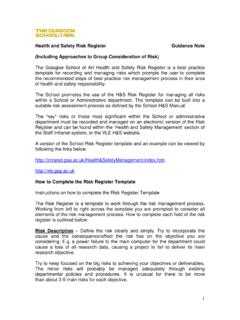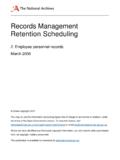Transcription of GSA Guide to Safe Use of Craft Knives - Glasgow School of Art
1 The Glasgow School of Art GSA Guide to safe Use of Craft Knives April 2016. Policy Control Title GSA Guide to safe Use of Craft Knives Date Approved Subject to Approval 11 May 2016. Occupational Health and Safety Committee Approving Bodies Occupational Health & Safety Committee Implementation Date April 2016. Supersedes Precautions When Handling Sharps (2009). safe Disposal of Hypodermic Needles and Sharps Guidance Note (2009). Supporting Policy Occupational Health And Safety Policy Procedure for Reporting Accidents , Incidents and Near Miss Events Review Date TBC. Author Ms Amy Moore, Health and Safety Adviser Date of Impact Assessment TBC. Benchmarking Edinburgh College of Art , Avoiding Cuts from Craft Knives Health and Safety Executive, Sharps Injuries GSA Guide to safe Use of Craft Knives Introduction Within Glasgow School of Art (GSA) the majority of accidents reported involve cuts or lacerations.
2 These are commonly caused by Craft Knives or scalpels and occur frequently in both studio and workshop spaces. Whilst many of these injuries are not classified as Specified Injuries under The Reporting of Injuries, Diseases and Dangerous Occurrences Regulations 2013 (RIDDOR), they do impact on those involved, particularly their ability to work as normal. The following guidance is based on the hierarchy of control central to all health and safety regulations in the UK. It is aimed at all staff and students carrying out activities which include this risk to assist them in minimising it. For the purpose of this guidance, the term Craft knife also includes scalpels and other open blade cutting instruments such as Stanley Knives . Please follow these steps when planning the use of Craft Knives : 1. Avoid Where possible, avoid the need to cut by: Using appropriate sized materials to minimize the need to cut.
3 Buying pre-cut materials. Considering alternatives for example, laser cutters 2. Safer alternatives Where cutting cannot be avoided, consider the use of alternatives to Knives , such as: Desktop trimmer. Guillotine. Scissors (of appropriate size). 3. Selecting the right equipment Where use of safer alternatives is not reasonably practicable, care should be taken to use appropriate equipment: Where possible, use retractable blades. All equipment should be in good condition sharp blades and a strong handle. Sufficiently sized cutting mats or boards. Safety rule. 4. Using equipment When cutting with a Craft knife, even with other appropriate equipment, safe cutting practices are essential: If you are unsure of how to safely use cutting equipment, speak to your tutor and/or a member of technical support staff. Always make sure the material to be cut is held firmly on a stable surface. Keep your other' hand behind the cutting blade at all times.
4 NEVER cut towards your body/hands. If necessary, secure work with pins or tape. Don't press too hard. If necessary, make a series of shorter cuts to keep control over long cuts. Be aware of others in the area (they may bump or distract you). Concentrate! 5. Storage The risk of injury from Knives is not limited to their use: Always cover the blade of a knife when not in use retract blade, proprietary covers, tubing sleeves, cork or robust storage case. Never leave open Knives unattended on desks. Never leave Knives on floors, chairs etc. where others might not expect to find them. Never put unprotected blades in your bag/pocket. 6. Maintaining equipment Particular care must also be taken when maintaining Knives : Take particular care when changing blades on surgical' style scalpels make sure you use the appropriate tools. Dispose of any blades correctly using sharps bins provided. 7. Accidents , Incidents and Near Misses (This guidance is adapted from the HSE website).
5 If you suffer an injury from a sharp: Encourage the wound to gently bleed, ideally holding it under running water. Wash the wound using running water and plenty of soap. Don't scrub the wound whilst you are washing it. Don't suck the wound. Dry the wound and cover it with a waterproof plaster or dressing. If necessary, seek assistance from a trained first aider. Report the injury using the GSA Accident/Incident Report Form.









